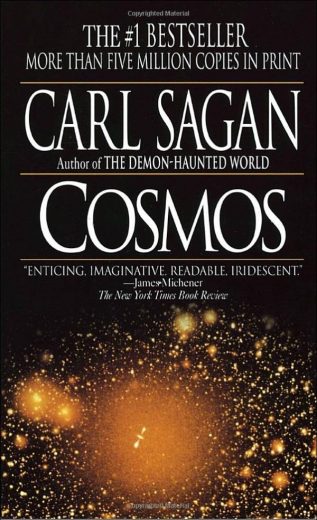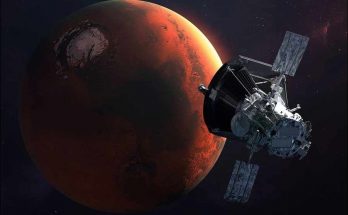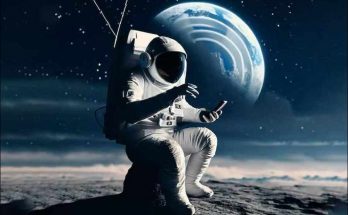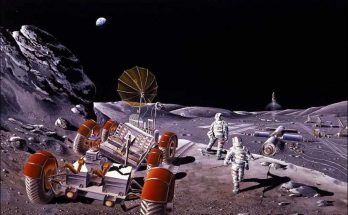“The cosmos is within us. We are made of star-stuff. We are a way for the universe to know itself.” ~ Carl Sagan.
I have read the 2009 fifth edition of Cosmos, one of Carl Sagan’s most important works, which is one of the few popular science books to enter the worldwide bestseller list. The book, which was first published in the United States in 1980 is a book of Sagan’s documentary series of the same name. Thinking that if scientific serials are published as a book, they will reach their goals and audiences better and make them permanent, he wrote 13 book chapters that correspond to 13 serial chapters, even more detailed than the serial.
Of course, a few photographs at the back of the book do not include the visuality of the series and therefore the expressiveness of visual communication tools, but it is certain that much more details and information can be conveyed with writing; because while time stands before us as a limit in the series, it is not possible to say that the same thing happens in the book.
Cosmos is a great bedside book containing Sagan’s most basic thoughts. Because while reading Cosmos, what happened in Sagan’s film Contact (Contact), which was also transferred to the big screen and made a mark with Jodie Foster’s magnificent acting, makes more sense and it can be understood on the basis of which thoughts the content of the film is shaped.
It is noteworthy that Sagan reduces all concepts to an understandable level, sometimes uses storytelling techniques, and sometimes makes people think and expresses the truth better with his humorous approaches; Because Sagan has always been appreciated in his own country for the same characteristics, and in the dozens of awards given to him, this point was especially mentioned and he was defined as the scientist who achieved the most success in the understanding of science by the public.
In this short review, I will make a few similar points, but more importantly, I will raise a few criticisms of the translation of the Golden Books.
Cosmos: A storybook of our world
Cosmos tells the importance of this curiosity in the civilization we have established, starting from the most basic emotion of people, “curiosity”, and while it covers how human beings discover the meaning of everything one by one after hundreds of thousands of years of wondering.
While doing all this, you learn what planets, stars, galaxies, quasars, black holes and pulsars are. If we had a space book in our hands, we would of course learn what all these concepts are with their definitions, but few books can teach this like a story, together with the thoughts of the early scientists in our history, the meanings attributed to them in the history of humanity, and the struggles to understand and tell the truth. . Of course, in the meantime, the dynamics of evolution, the definition of life, etc. It also tells about the subjects that it is not possible to call Cosmos just a “space book”.
Cosmos is a “life book” that deals with life from the perspective of the universe. The Cosmos does not follow the standard path of a familiar book. We cannot say that the parts of the cosmos go in chronological order, celestial size, a certain importance, a certain order… No! The Cosmos, like itself, presents big and complex ideas in a pattern, but in a very clear and beautiful way, giving you time to digest. That’s why when you read Cosmos, you may feel more like you are reading a storybook.
Cosmos may be an old book, but…
Cosmos is a book written in 1980. A novel published in 1980 can continue to be read today without losing any of its value and meaning, but the same cannot be said for a science book; because science is constantly advancing.
Not updating the information received from the Cosmos while reading it may lead to incorrect information at some points. As I stated in the first sentence, it is not an error or problem of this book, it is due to the rapid progress of science. We are in an age where we cannot expect a book on astronomy to be valid for 600-700 years, as in ancient times.
To cite a few examples, no planets outside the solar system had yet been discovered when Cosmos was written, and all known planets were only those found in our solar system. Therefore, throughout the book, it is always given as a possibility, as a hope, that there may be planets belonging to other stars besides the solar system. There are more than 600 planets discovered outside the solar system today.
In this sense, although the book lagged behind the times, it is a pleasure to see Sagan’s excitement and hope in this direction. Similarly, we know today that there are 8 planets and 5 dwarf planets in our solar system. Dwarf planet is a new term. When Sagan wrote his book, Pluto, which is defined as a dwarf planet today, was considered a planet and it was said that there were 9 planets in our solar system.
But… In order to understand science today, it is useful to examine science in its historical line. Someone came to me today and said, “I’m also studying physics, astronomy, astrophysics, etc. I want to have information on the subjects, where do I start?” If he said that, I would tell him to follow the relevant topics chronologically and therefore start from the old books so that he can understand the topics he is talking about in the best and deepest way.
Cosmos is a very good introductory book if, after reading, it can be changed with up-to-date information by following the relevant topics, because in Cosmos, starting from Ancient Greece and Ionia, it comes to the present through Copernicus, Galileo, Kepler, and historical thoughts about planets and stars are handled one by one. (At one point, Sagan even thinks of himself as the child of a tribe that lived as hunters/gatherers 10,000 years ago and narrates his narrative.)
Views: 400





